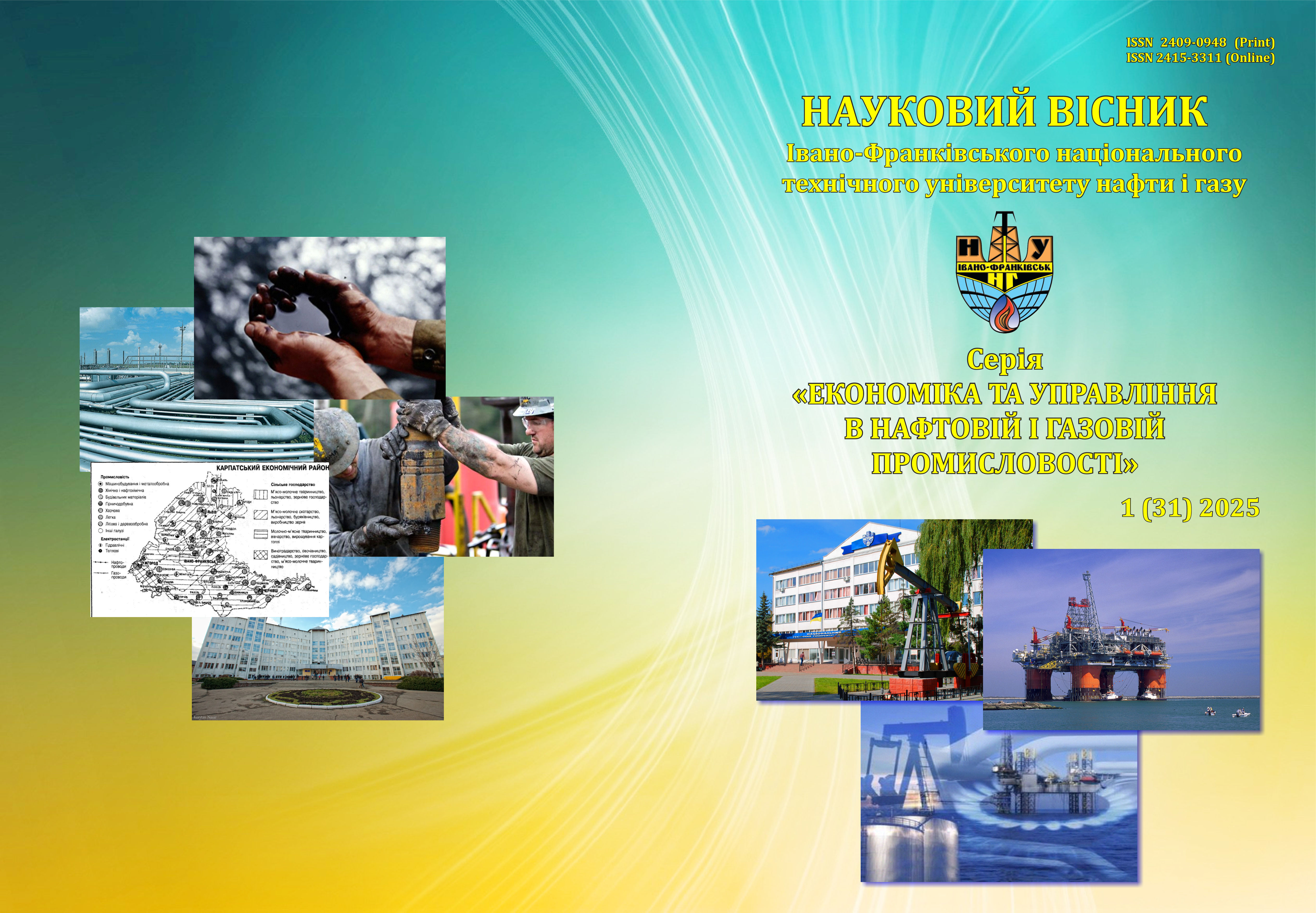MATRIX STRUCTURE OF THE CONTROL SYSTEM OF A GAS TRANSPORTATION ENTERPRISE WITH THE DEMARCATION OF THE PLACE OF ECONOMIC EXPERTISE
DOI:
https://doi.org/10.31471/2409-0948-2025-1(31)-68-79Keywords:
gas transportation enterprise, controlling system, economic expertise, management, risks, energy security, gas transportation, demarcation, monitoringAbstract
Modern challenges in the energy sector place high demands on transparent and flexible management of gas transportation enterprises. The importance of comprehensive controlling, which covers not only internal financial and production indicators, but also takes into account macroeconomic factors, is due to the complexity and interconnectedness of the gas distribution system of Ukraine. Any change in the operating mode of a separate element (pressure in the gas pipeline, production volumes) causes a chain reaction in all related links, which can have significant financial and economic consequences. In this context, the demarcation of the place of economic expertise in the general controlling system is of particular importance: it provides a deeper analysis of external risks, allows modeling market scenarios, taking into account regulatory requirements and price volatility on energy exchanges. The key structural elements that ensure integrated management are considered: organizational structure, financial and economic blocks, technical and production units and monitoring system. Along with this, the main components of controlling are highlighted, including operational and strategic analysis, risk management and personnel performance assessment. It is demonstrated that a comprehensive combination of these elements and approaches increases the level of readiness of the enterprise to external challenges, increases the transparency of costs and revenues, and also contributes to the optimization of gas transportation processes. Special attention is paid to the relationship with the general gas distribution system of Ukraine, where any technical or market change requires a quick analytical response. The use of controlling tools with economic expertise allows gas transportation enterprises not only to manage current operations more effectively, but also to form a strategic vision of development, based on accurate calculations, risk management and long-term planning. The results of the study can become the basis for the implementation of innovative approaches to management in the gas transportation industry and provide the necessary flexibility in a rapidly changing environment. The transcription of the matrix structure of the controlling system of a gas transportation enterprise with the democratization of the place of economic expertise is schematically presented.
References
Kostiuk, O., & Bubela, T. (2023). Upravlinnia ta identyfikatsiia ryzykiv na hazotransportnykh pidpryiemstvakh [Management and identification of risks at gas transport enterprises]. Measuring and Computing Devices in Technological Processes, 4, 216–224. [in Ukrainian]. https://doi.org/10.31891/2219-9365-2023-76-29
Vasilega, V. (2024). Kontrolinh v systemi zabezpechennia ekonomichnoi bezpeky pidpryiemstva v protsesi adaptatsii do umov tsyklichnoi ekonomiky [Controlling in the system of ensuring economic security of the enterprise in the process of adaptation to the conditions of the cyclical economy]. Ekonomika ta Suspilstvo, 66. [in Ukrainian]. DOI: https://doi.org/10.32782/2524-0072/2024-66-17
Belenkova, O. Yu. (2018). Sutnist operatyvnoho kontrolinhu ta yoho rol v upravlinni pidpryiemstvom [The essence of operational controlling and its role in enterprise management]. Efektyvna Ekonomika, 4. [in Ukrainian]. URL: http://www.economy.nayka.com.ua/?op=1&z=6242
Horal, L. T., & Zapukhliak, I. B. (2015). Suchasni pidkhody do upravlinnia vytratamy vitchyznianykh hazotransportnykh pidpryiemstv [Modern approaches to cost management in domestic gas transport enterprises]. Naftohazova Haluz Ukrainy, 5, 13–15. [in Ukrainian].
Shtangret, A., Silkin, O., & Shliakhetko, V. (2024). Trudova mihratsiia yak zovnishnia zahroza dlia kadrovoi bezpeky pidpryiemstva [Labor migration as an external threat to the personnel security of the enterprise]. Naukovi Innovatsii ta Peredovi Tekhnolohii, 10(38), 190–201. [in Ukrainian]. DOI: https://doi.org/10.52058/2786-5274-2024-10(38)-190-201
Kaplina, A. (2021). Kontrolinh yak instrument upravlinnia pidpryiemstvom [Controlling as a tool for enterprise management]. Ekonomika ta Suspilstvo, 23. [in Ukrainian]. DOI: https://doi.org/10.32782/2524-0072/2021-23-16
Rumyk, I. (2020). Kontrolinh u systemi upravlinnia finansovoiu bezpekoiu pidpryiemstv [Controlling in the system of financial security management of enterprises]. Vcheni Zapysky Universytetu "KROK", 4(60), 47–56. [in Ukrainian]. DOI: https://doi.org/10.31732/2663-2209-2020-60-47-56
Sopko, V. V., & Romashko, O. N. (2012). Kontrolinh yak zasib zabezpechennia systemy ekonomichnoi bezpeky pidpryiemstva [Controlling as a means of ensuring the system of economic security of the enterprise]. Aktualni Problemy Ekonomiky, 2, 176–179. [in Ukrainian]. URL: http://nbuv.gov.ua/UJRN/ape_2012_2_21
Voychenko, T., Halkievych, M., & Radchenko, O. (2024). Efektyvnist upravlinnia vytratamy u transportnykh kompaniiakh: rol marketynhovoho kontrolinhu u zabezpechenni konkurentospromozhnosti [Efficiency of cost management in transport companies: the role of marketing controlling in ensuring competitiveness]. Ekonomika ta Suspilstvo, 68. [in Ukrainian]. DOI: https://doi.org/10.32782/2524-0072/2024-68-103
Shtangret, A., & Silkin, O. (2024). Bezpekovyi aspekty upravlinnia personalom v umovakh hiperdynamichnoho zovnishnoho seredovyshcha [Security aspects of personnel management in conditions of a hyper-dynamic external environment]. Naukovi Innovatsii ta Peredovi Tekhnolohii, 9(37), 227–237. [in Ukrainian]. DOI: https://doi.org/10.52058/2786-5274-2024-9(37)-227-237
Downloads
Published
How to Cite
Issue
Section
License
Copyright and Licensing Terms
Copyright Statement
The authors who publish in the journal accept the following conditions:
- The authors retain the copyright and grant the journal the right of first publication, licensed with Creative CommonsCC BY-NC-SA , which permits other people to remix, transform, and build upon the material and use the material for non-commercial purposes, give appropriate credit and distribute the contributions under the same license as the original.
- The authors can conclude additional agreements on the non-exclusive distribution of the journal’s published version of the work (for example, publication of the work in electronic repositories) with an acknowledgment of its initial publication in this journal.
- The authors can upload the published articles on the Internet (for example, in electronic repositories or on web-sites), as it will stimulate fruitful scholarly discussions and increase the citation rates of the published articles.


1.png)


1.png)





